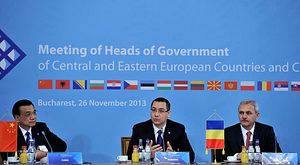Hungary in recent months has been associated with a Belt and Road fiasco, as work for the Hungarian stretch of the Belgrade-Budapest railway – China’s most ambitious transport project in Europe – has been halted for allegedly violating EU public procurement laws. But next Monday setbacks will be glossed over by grandiose symbolism as the Hungarian capital prepares itself to welcome the heads of government of China and 16 Central and Eastern European countries (CEEC). In fact, while Beijing has yet to deliver on its promises for infrastructure investment in the region, it has been working full steam on institutionalizing its cooperation with Eastern Europe, shaping the 16+1 initiative into a platform for its Belt and Road Initiative (BRI). This is turning into a stress test for EU cohesion.
Established in Warsaw in 2012, the 16+1 framework for cooperation is China’s most advanced sub-regional diplomatic initiative in Europe, involving 11 Central and Eastern European EU member states and five Balkan states, each in the process of negotiating their accession to the EU. In the aftermath of the financial crisis, Beijing initiated this format with the promise to foster investment, economic and trade cooperation, and to bring connectivity projects to the region. After the launch of Beijing’s signature Belt and Road Initiative (BRI) in 2013, the format has turned into a platform for China to develop infrastructure projects to connect Asia to Europe – with the aim to facilitate Chinese access to the European market, to export China’s excess capital and labor, and to build its global power.
Institution Building Shows Dynamism in 16+1 Political Relations
So far at least, China’s economic engagement in the region lags far behind its promises. Despite last year’s announcement of a 10 billion EUR investment fund for infrastructure projects in Central and Eastern Europe, most Chinese investment in Europe has been mainly directed to Europe’s four largest countries in the West, the United Kingdom, Germany, Italy, and France. Hungary is an exception in Eastern Europe, as it has obtained significant investment. At the same time, the Belgrade-Budapest railway – a landmark BRI project – is still blocked by an EU investigation trying into whether it violated EU laws on public tender processes.
While China’s promises for increased economic cooperation have yet to materialize, political cooperation and institution building with Eastern European countries have moved ahead at a remarkable pace. The 16+1 format now involves regular ministerial conferences such as the first China-CEEC Ministerial conference on energy cooperation that was held in Bucharest on November 8. A two-day meeting of China-CEEC transport ministers in Warsaw in October led to the creation of a 16+1 Coordinating Secretariat on Maritime Issues.
With the upcoming summit in mind, governments from the Baltic to Eastern Europe have praised their countries as suitable destinations for Chinese investment under BRI-labelled infrastructure projects. Latvia pledged to strengthen cooperation on transport and logistics, infrastructure investments, trade and tourism. Hungary intends to launch a tender for the Hungarian stretch of the Belgrade-Budapest railway at next week’s summit. Bulgaria hosted a 16+1 forum branding Plovdiv as “the oldest city on the Silk Road.” During the October 16+1 meeting of transport ministers in Warsaw, the Polish prime minister referred to a plan for a new airport hub in Poland, which would be combined with a high-speed railway connecting Europe and Asia, while Slovenia’s infrastructure minister promoted his country as a major logistics hub in Central Europe, with logistics centers in Ljubljana, Maribor, and Koper, and the Port of Koper connecting commercial ports in the Northern Adriatic.
A Stress Test for EU Cohesion
In light of these countries’ high expectations for economic gains, next week’s summit is a stress test for EU cohesion. The EU has viewed the 16+1 format with concerns since 2015. A 2015 European Parliament’s resolution called on EU member states to “speak with one voice to the Chinese government, particularly in view of Beijing’s present diplomatic dynamism.” The text took note of Chinese expanded diplomacy activities in Central and Eastern Europe and stressed that the “16+1 group should not divide the EU or weaken its position vis-à-vis China and should also address human rights issues.”
China and CEEC countries have presented the format as a positive contribution to EU-China relations. On the sidelines of the recent ASEAN-EU summit, Chinese Premier Li Keqiang reassured European Council President Donald Tusk that, “cooperation between China and CEEC countries is conducive to the comprehensive and balanced development of China-EU relations and to European integration as well.”
But European integration seems very much at stake when Eastern European governments use their relationship with China to gain leverage over Brussels. This became clear when Macedonian President Ivanov claimed that the EU’s neglect of the Balkans was forcing these EU accession candidates states to turn to China for investment.
The importance of next week’s summit goes beyond potential new Chinese promises or announcements of investments in CEEC countries. The 16+1 cooperation is full of symbolism that can threaten the cohesion within the EU if left unaddressed.
































